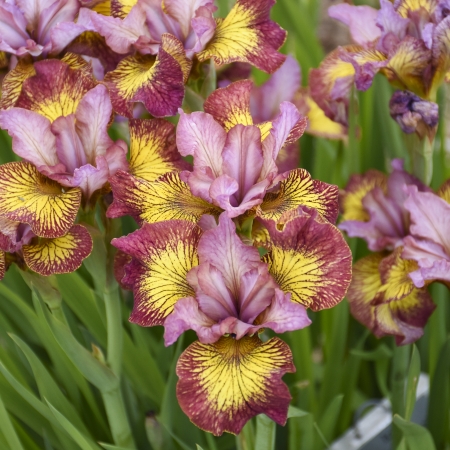Iris sibirica (Siberian Iris)
×
Color Name: Fiddles on Fire
This compact Siberian Iris stands out with its beautiful mauve-rose flowers, accentuated by striking yellow flares and intricate mauve veining. Despite its smaller size of less than 2 feet tall, Fiddles on Fire delivers a fiery display that adds a vibrant touch to any garden setting.
Siberian irises are haled for their elegant, delicate flowers and disease resistance. They perform admirably in the sunny to partially shady garden, but need plenty of water throughout the season to continue looking their best. In naturalized settings, they are particularly effective around water features. They can also be grown under Black Walnut trees since they are not effected by juglone. Siberian Irises bloom before Japanese Irises but after Tall Bearded Irises.
Growing Tips: Location: Choose a spot with full sun (at least six hours per day) for the best blooms. Afternoon shade is beneficial in very hot climates.
Soil: These plants prefer rich, acidic soil with a pH of 5.0-6.5.
Mix in plenty of organic matter, such as compost or well-aged manure, to improve fertility and moisture retention. Do not add lime or wood ash, as this is harmful to Japanese irises.
Depth: Plant the rhizomes deeper than other iris varieties, about 2 to 3 inches deep, to account for their upward growth habit.
Spacing: Space individual rhizomes 18 to 24 inches apart to give them room to grow.
Initial care: After planting, soak the roots overnight before planting, and water thoroughly to settle the soil.
This compact Siberian Iris stands out with its beautiful mauve-rose flowers, accentuated by striking yellow flares and intricate mauve veining. Despite its smaller size of less than 2 feet tall, Fiddles on Fire delivers a fiery display that adds a vibrant touch to any garden setting.
Siberian irises are haled for their elegant, delicate flowers and disease resistance. They perform admirably in the sunny to partially shady garden, but need plenty of water throughout the season to continue looking their best. In naturalized settings, they are particularly effective around water features. They can also be grown under Black Walnut trees since they are not effected by juglone. Siberian Irises bloom before Japanese Irises but after Tall Bearded Irises.
Growing Tips: Location: Choose a spot with full sun (at least six hours per day) for the best blooms. Afternoon shade is beneficial in very hot climates.
Soil: These plants prefer rich, acidic soil with a pH of 5.0-6.5.
Mix in plenty of organic matter, such as compost or well-aged manure, to improve fertility and moisture retention. Do not add lime or wood ash, as this is harmful to Japanese irises.
Depth: Plant the rhizomes deeper than other iris varieties, about 2 to 3 inches deep, to account for their upward growth habit.
Spacing: Space individual rhizomes 18 to 24 inches apart to give them room to grow.
Initial care: After planting, soak the roots overnight before planting, and water thoroughly to settle the soil.
|
Flower Color: Red/Yellow Shades Foliage Color: Green Shades
Height: 20 to 22 Inches Spread: 18 to 24 Inches Hardy in Zone: 4, 5, 6 |
Blooms: Late Spring / Early Summer
Foliage Season: All Season |
Growth Rate |
Medium
|
Attributes |
Border Cut Flower or Foilage Easy to Grow Landscapes Mass Planting Specimen Plant
|









